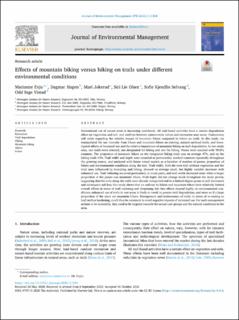Effects of mountain biking versus hiking on trails under different environmental conditions
Evju, Marianne; Hagen, Dagmar; Jokerud, Mari; Olsen, Siri Lie; Selvaag, Sofie Kjendlie; Vistad, Odd Inge
Peer reviewed, Journal article
Published version

Åpne
Permanent lenke
https://hdl.handle.net/11250/2685893Utgivelsesdato
2020Metadata
Vis full innførselSamlinger
- Publikasjoner fra CRIStin - NINA [2397]
- Scientific publications [1423]
Originalversjon
10.1016/j.jenvman.2020.111554Sammendrag
Recreational use of nature areas is increasing worldwide. All trail-based activities have a certain degradation effect on vegetation and soil, and conflicts between conservation values and recreation may occur. Controversy still exists regarding the relative impact of mountain bikers compared to hikers on trails. In this study, we manipulated the use intensity from hikers and mountain bikers on existing, natural-surfaced trails, and investigated effects of increased use and the relative importance of mountain biking on trail degradation. In two study sites, two trails were selected, one designated for hiking and one for biking. Passes were counted with TRAFx counters. The proportion of mountain bikers on the designated biking trails was on average 47%, and on the hiking trails 13%. Trail width and depth were recorded at permanently marked transects repeatedly throughout the growing season, and analyzed with linear mixed models as a function of number of passes, proportion of bikers and environmental conditions along the trail. Trail width, both the core trail without vegetation and the total area influenced by trampling and biking, showed on average small, but highly variable increases with enhanced use. Trail widening occurred particularly in moist parts, and trail width increased more when a larger proportion of the passes was mountain bikers. Trail depth did not change much throughout the study period, suggesting that the soils along the trails were already compacted and to a limited degree prone to soil movement and subsequent soil loss. Our study shows that on-trail use by hikers and mountain bikers have relatively limited overall effects in terms of trail widening and deepening, but that effects depend highly on environmental conditions; enhanced use of trails in wet areas is likely to result in greater trail degradation, and more so if a large proportion of the users are mountain bikers. Management and maintenance of trails, in terms of re-routing or trail surface hardening, could thus be necessary to avoid negative impacts of increased use. For such management actions to be successful, they need to be targeted towards the actual user groups and the natural conditions in the area. Recreation Trail degradation Hiking Mountain biking Alpine Forest
